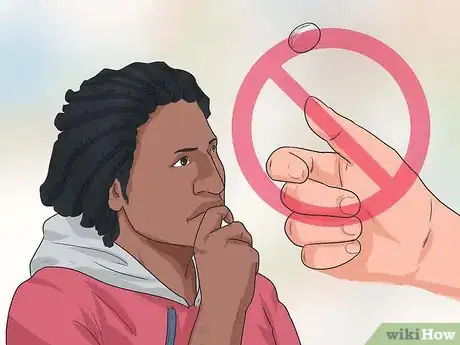This article was co-authored by Trudi Griffin, LPC, MS. Trudi Griffin is a Licensed Professional Counselor in Wisconsin specializing in Addictions and Mental Health. She provides therapy to people who struggle with addictions, mental health, and trauma in community health settings and private practice. She received her MS in Clinical Mental Health Counseling from Marquette University in 2011.
There are 11 references cited in this article, which can be found at the bottom of the page.
This article has been viewed 168,386 times.
So often in life we have to make tough decisions. Making a decision to do something new usually involves giving up something else. That's what makes it hard—there's a loss to deal with as well as the uncertainty of the future. However, we often overestimate how important our decisions will ultimately be for our happiness and sense of well-being. By making decisions in the right mindset and reminding yourself that you're rarely stuck with whatever decision you make, you'll find it easier to make decisions for yourself -- even the tough ones.
Steps
Getting Yourself in the Right Mindset
-
1Document your hesitations. If you feel stuck and are unable to make a tough decision, write down on paper what is holding you back. Ask yourself if you are unable to make a decision because you fear what the outcome will be. If this feels true for you, keep in mind that people often overestimate how strongly future decisions will make them feel. This is known as "affective forecasting," and in general, humans are not very good at it.[1]
- That is, the decision you end up making will likely have less impact on your overall happiness, once you have had time to adjust to it, than you think. Use this information to help you override your fear to make a decision one way or the other.
-
2Compare what you know to what you should ideally know. Think about both sides of the issue that is at stake in your decision. For example, if you are thinking about getting a new job and one thing drawing you to it is a salary increase, ask yourself whether you know how large the salary increase would be.[2]
- If you are short on information, research the topic by going online and checking average salary information (Google "average salary + X", with X being your potential job title), asking colleagues in your field what they have heard about the salary information, and, when the time is right, asking your new potential employer directly.[3]
- You can also gather information by asking people who have made similar decisions to you in the past, or who have been in similar predicaments. For example, if you know someone who took the job you are considering, ask her what her experience has been like. Be sure to compare and contrast her life circumstances with your own.
- If she really enjoys her new job and liked moving to a new city, but she is single, whereas you would be leaving your partner behind for a year or longer, your level of enjoyment at relocating for the new job may not actually be matched.
Advertisement -
3Assess whether others are holding you back. Sometimes we fear making decisions because we are afraid of what others will think. If you value your own happiness and view yourself as the ultimate driver of your life then keep in mind that ultimately you should make your own decisions for yourself.[4]
- Ask yourself if, before you act, you often worry about what others will think. If you answered yes, it may be that others are holding you back from making a decision.
- If a fear of social disapproval is holding you back, think about how you alone would feel about the decision.[5] That is, do your best to remove from your mind others who might judge you for your decision.
-
4Map out how final your decision really is. Sometimes we hesitate to make decisions because we think that they cannot be undone. To be sure, sometimes this is true. Often, however, we can reverse our decisions either fully or partially. So, it is often true that making a decision should not feel like a huge burden that causes emotional turmoil.
- Carefully consider the finality of your decision. For example, you could ask yourself the following questions about relocating for a new job: Would you be stuck there forever or could you re-apply for your old job or for other jobs back where you used to live? Could you apply for similar positions in a new city if you did not end up liking your new location?
-
5Check for underlying depression. When we are feeling down it can be very difficult to make decisions. Our cognitive resources feel depleted and even small tasks or simple decisions can feel like colossal undertakings.[6]
- To check to see whether you feel depressed, ask yourself lately how often you have felt down. If you have felt down for an extended period of time (longer than two weeks), or if you have noticed that you don't enjoy things that you used to like, you may be depressed. Keep in mind though that the only proper way to be diagnosed is to see a mental health professional.[7]
-
6Take a break. Sometimes we cannot identify all the sources of difficulty or come to make a decision, and that is alright. Try taking a break and remember that your unconscious mind is probably still working on solving the problem even when you are not aware of it.[8]
-
7Drop the belief that there is a perfect decision. Perfectionism creates an unrealistic view of the world, and can create anxiety and disappointment because you hold yourself to an unattainable standard. No matter your decision or environment, there will still be things that are difficult and that you would prefer not to deal with. If you are torn on a decision because you are waiting for a perfect option to come along, keep in mind that the perfect path is very unlikely to exist.[9]
- In order to achieve this, remind yourself, when you are struggling to decide, that no decision option is going to be perfect, that there will likely be some drawbacks to each major decision that you make.
-
8Try to look for an alternate option. One reasons decisions can be tough is that we often get drawn into an "either/or" situation. For example, if you're debating taking a new job, your thinking might go along the lines of "Either I take this new job that I'm not entirely happy with or I stay in my current dead-end position." However, if you looked for an alternate option, you would discover that you're likely not limited to those two options. You might have another option, such as taking the new job and continuing to look for a better position, or declining the job and continuing your search for something better.[10]
- Studies suggest that if you can add even one alternate option, you're more likely to make a good decision. This is probably because you're not thinking in limited, inflexible terms, which allows you to be more open to possibilities you may not otherwise have considered.
Weighing Both Sides of the Decision
-
1Create a list of pros and cons. Sometimes tough decisions can feel overwhelming and it can be difficult to keep all the facts, pros, and cons straight. To aid you in not feeling overwhelmed, write things out in a concrete way.[11]
- Create a two column table, one column for a list of pros (i.e., things that would be or might be good if you made the decision) and one column for a list of cons (i.e., things that would be or might be bad if you made the decision).
-
2Estimate the certainty of each pro and con. Not every good or bad thing about your decision is equally likely to occur. Consider this (exaggerated) example: if you have a chance to move to Hawaii but you are scared of a volcano erupting, because the chance of this happening is so small, you should not weigh it too heavily in your decision-making process.
- For example, if you are making the decision on whether to accept a new job things that may be in your pro column could include: new environment, chance to make new friends, pay raise.
- In your cons column you may include: would have to relocate, would be challenging to start a new job when comfortable in old job, future is more uncertain than it is now.
-
3Notice the subjectivity of your pros and cons. Some people may find relocating to a new city to be a pro, whereas others like to stay put in the same spot and would dislike this.
- Keep in mind, when you rate the certainty of the items in your list, that you may find yourself pleasantly surprised. For example, you may find that moving to a new city is not as negative an experience as you would have thought.
- You could weigh the certainty of your items in the following way. For your pro list, you would certainly be in a new environment (100%)
-
4Weigh your pros and cons. Assess how important each pro and con is to you on a scale from 0 to 1.
- For example, if you think it would be only somewhat exciting to be in a new environment, you might rate the importance of that variable as .30.
-
5Calculate value. Multiply the certainty of the variable times how important it is to you to get a sense of the ‘value’ of that item.
- For example, since you would certainly be in a new environment if you changed jobs, and you assigned 'new environment' a value of .30, you would multiply .30 (the value) by 100 (the certainty), for a value of 30. So, your value for being in a new environment would be + 30.
- To take another example, if your certainty value for a chance to make new friends is 60% but it is very important to you to expand your network of friends, you may rate it as having an importance of .9. So, multiplying 60 by .9 gives 54. In this case, even though it isn't certain that you would make new friends at your new job, it is important to you so you should place more emphasis on it in your decision-making.
- You would then sum 30 + 54, plus the value of your other pros, to get your total value for your pros side.
- You would then do the same thing for your cons side.
-
6Be very careful before deciding. Creating a list of pros and cons isn’t always the best way to make a decision because it can have a number of drawbacks. Be sure, if you are choosing to make a decision this way, that you are not falling for one of these drawbacks.[12]
- Make sure that you do not over-analyze your situation by creating ‘pros’ or ‘cons’ that may, to an outsider, seem good or bad but in actuality are not things that you, personally, care about one way or another.
- In line with this idea, do not ignore your gut feelings when you are making a list like this. Sometimes our gut feelings are difficult to put into words and so they can’t be placed on a list; but those feelings are real and should be carefully considered and valued.[13]
-
7Avoid taking in too much information. Sometimes having too much information can actually constrain your ability to make a decision. For example, a very complicated pros and cons list makes it very difficult to keep track of all the variables involved and all the ways they are valued to you and all the complex ways they may interact. Being inundated with too much information can actually change your decision-making for the worse.[14]
- Consider listing 5 pros and 5 cons, to start with. Particularly if you weight them, you will likely not need very many to help you make your decision.[15]
-
8Decide by value. If the value of your pro side is larger than the value of your cons side, you can choose to make a decision based off of that. In that case, it seems like a better idea to make the decision than to not make it.
Avoiding Common Mistakes
-
1Watch for confirmation bias. This type of bias is very common. This happens when you look for information that confirms what you already know (or think you know) about a situation. This can lead you to make poor decisions because you aren't considering all the relevant information.[16]
- Making a pros and cons list will help you, but only so far, because it is easy to discount information that you don't want to pay attention to. Ask others about your thoughts and opinions to ensure that you're taking everything into account. You don't have to base your decision on their thoughts, but considering their viewpoints can help combat confirmation bias.
-
2Avoid the gambler's fallacy. This bias occurs when you expect past events to influence or recreate future events. For example, if a coin comes up "heads" 5 times in a row, you might begin to expect that it will come up "heads" again, despite the chances of each coin toss being exactly 50/50. When making tough decisions, make sure that you take your past experiences into account, but don't let them incorrectly influence your perception.[17]
- For example, if you're trying to decide whether to marry someone and you have a past failed marriage, you might allow that to dissuade you. However, you should take all the data into account here: are you different from the person you were when you got married the first time? Is your partner different than your previous partner? What is this relationship like on its own? These will help you make an informed decision.
-
3Watch for the sunk cost fallacy. When making tough decisions, you may fall prey to the sunk cost fallacy. This occurs when you focus so much on what you've invested in a situation that you fail to see when it is a wiser decision to just let go. This is economically known as "throwing good money after bad."[18]
- For example, if you've bet $100 on a hand of poker and your opponent keeps calling, it could be difficult for you to realize that your hand is beaten. You might keep raising the bet because you've already invested a lot of money, even though your hand is no longer the strongest.
- To take another, example, say you bought some tickets to the opera. On the night of the event, you feel sick and really do not want to go. But, because you bought the tickets, you go anyways. Because you are not well and did not want to go, you have a miserable time. The money was already spent regardless of whether you went to the opera or not, and so, a better decision would probably have been to just stay at home and rest.
- If you find yourself leaning to one side of a decision because you've "already invested" a lot of time, effort, or money into it, take a step back to consider your decision again. While it is not always a bad idea to stick with something, don't let the fallacy trap you into a decision that isn't really in your best interest.
Warnings
- Do not rush into any major decision. Carefully weigh your options and sleep on it before you decide.⧼thumbs_response⧽
References
- ↑ http://wjh-www.harvard.edu/~dtg/Wilson%20&%20Gilbert%20(Advances).pdf
- ↑ http://www.mindtools.com/pages/article/newTED_00.htm
- ↑ https://www.psychologytoday.com/blog/in-love-and-war/201505/10-keys-making-your-mind
- ↑ http://www.mindtools.com/pages/article/newTED_00.htm
- ↑ https://www.psychologytoday.com/blog/in-love-and-war/201505/10-keys-making-your-mind
- ↑ https://www.psychologytoday.com/blog/the-creativity-cure/201408/why-is-it-difficult-make-decisions
- ↑ http://www.apa.org/helpcenter/understanding-depression.aspx
- ↑ https://www.psychologytoday.com/blog/in-love-and-war/201505/10-keys-making-your-mind
- ↑ https://www.psychologytoday.com/blog/in-love-and-war/201505/10-keys-making-your-mind
- ↑ http://www.marketplace.org/topics/life/big-book/how-make-good-decisions-hint-proscons-list-wont-help
- ↑ http://leandecisions.com/2012/09/how-to-create-an-effective-weighted-pro-con-list.html
- ↑ http://www.businessinsider.com/psychologist-pros-cons-list-bad-idea-decisions-2015-6
- ↑ http://www.businessinsider.com/psychologist-pros-cons-list-bad-idea-decisions-2015-6
- ↑ https://www.psychologytoday.com/blog/glue/201212/why-too-much-data-disables-your-decision-making
- ↑ http://leandecisions.com/2012/09/how-to-create-an-effective-weighted-pro-con-list.html
- ↑ http://www.mindtools.com/pages/article/avoiding-psychological-bias.htm
- ↑ http://www.mindtools.com/pages/article/avoiding-psychological-bias.htm
- ↑ http://insight.kellogg.northwestern.edu/article/is_the_sunk_cost_fallacy_actually_smart_business
About This Article
If you want to make a tough decision, start by thinking about the positive and negative sides of the issue. Thinking of the pros and cons can help you decide if the decision is worth the risk, and give you a sense of what each option will look like down the road. Additionally, cast your mind to 1, 3, and 5 years down the road – will one decision lead to a better future outcome? Thinking of your future may help you decide if the risks are worthwhile. If you're still unsure, keep in mind that most decisions can be undone, so try not to let the pressure get to you. For more advice, including why you shouldn’t look for information that confirms what you already know about a situation, read on

















































































